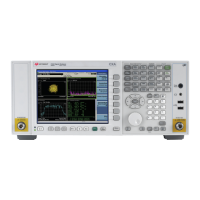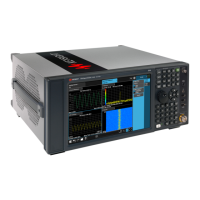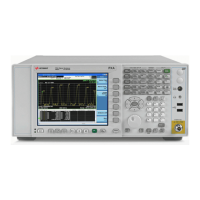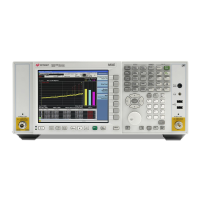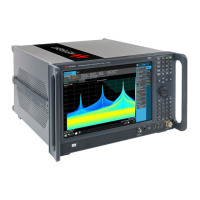632
Functional Tests
BBIQ Input Frequency Response (Option BBA only)
19.Press Peak Search on the X-Series analyzer. Record the marker amplitude
reading in Table 16-10 for the I Input at 250 kHz.
20.Set the RF Signal Generator to each of the remaining frequencies listed in
Table 1, up to the maximum IQ bandwidth of the X-Series analyzer. At
each frequency, do the following:
a. Press Peak Search
b. Record the marker amplitude reading in Table 16-10 for the I Input
at the current RF Signal Generator frequency
NOTE Since the input is set for I + Q and the input signal is being applied to I only,
the analyzer will measure 6 dB lower than the signal generator output; in this
case
-10 dB - +6 dB = -16 dB
This will be the case for I, I, Q, and Q inputs.
This is because the Fourier transform of
Asin (w+) = Am(W-w) + 1/2 Am(W+w).
Since a signal is placed at w or -w, the result will be 20log(1/2) lower.
The transform is in voltage and not power.
21.Connect the BNC Cable between the RF Signal Generator RF Output and
the Q input on the X-Series analyzer, see Figure 16-10
22.Connect the 50 Ohm termination to the Q input on the X-Series analyzer,
see Figure 16-10
23.Set the RF Signal Generator frequency to 250 kHz.
24.Press Peak Search on the X-Series analyzer. Record the marker amplitude
reading in Table 16-11 for the Q Input at 250 kHz.
25.Set the RF Signal Generator to each of the remaining frequencies listed in
Table 16-11, up to the maximum IQ bandwidth of the X-Series analyzer. At
each frequency, do the following:
Press Peak Search
Record the marker amplitude reading in Table 16-11 for the Q Input at the
current RF Signal Generator frequency
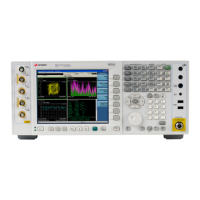
